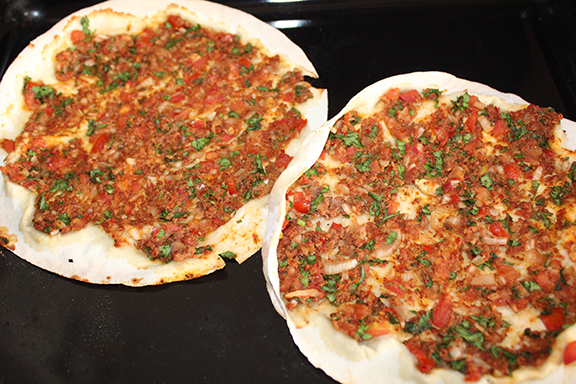BY SARKIS RSHDOUNI
Special to Asbarez
Every culture on this planet has their own ethnic cuisine, however, it is hard to believe that there is one type of food represented by one specific culture, in this day and age.
As I, being part Armenian, part Assyrian, and part Greek, born and raised in the eastern part of Syria; the Lower Mesopotamia, and Aleppo, the heaven of Middle Eastern cuisine, literally, I had the chance to eat wholeheartedly all types of food and national and ethnic cuisines, such us, of course Western Armenian, Assyrian, Levantine, Arabic, Mediterranean and more. Even with all these options at my disposal, I chose to become a vegetarian at the age of 14, perhaps a very rare commitment in Syria.
Since my graduation from Yerevan State University, Faculty of History, it was my obsession to find the origins and etymology of not just language, but actual titles and colloquialism of all the dialects of Armenian used today. Hence, I started with one of the most popular and loved foods of the Armenian culture: LAHMAJO(UN).
I have come across several blogs, articles, and personal testimonies regarding “Lahmajo,” with the word being of Arabic in origin, whilst the actual food is not. I have concluded in my extensive research that the food that we call “Lahmajo(un)” has spiritual pagan origins dating back to the late Iron Age 900-650 BC, at the very least. Allow me to explain further starting with:
Authentic Ingredients
Flour, water, salt, ground meat, baked into a thin crust in a pit oven, known as Tandoor or Tonir.
It is very obvious that the thin crust was inspired by Lavash itself and the meat was beef, to be more specific, it was HEIFER (young cow, not calf).
The reader must wonder, why Lavash and why heifer meat?
The Answer goes back circa 2100 years ago, during the Artashesian reign (Artaxiad Dynasty).
Why Lavash? Lavash is the most sacred food among the Armenian people through out history. Making Lavash is a sacred ritual that requires a lot of dedicated physical work and back in the ancient times it was committed only by women. Armenian women solely dominated the Lavash making tradition, and the reason behind it is simply very obvious; women represent the Godess Anahit’s elements, traits, and divine feminine energy, where the Tonir oven represents the womb creating and birth-giving in this world and thus they have the blessing of Goddess Anahit to prepare the main part of their food, which is the bread of life. Lavash also used to be given as gifts and offerings to Goddess Anahit during rituals and holidays as a symbol of fertility and prosperity and even protection.
Armenian Historian Hamazasp Khachatryan explains this in his book titled “A Form Of Worshipping Goddess Anahit in Ancient Shirak,” where he states firsthand accounts of Greek Historian Plutarchus (1st century AD) witnessing the heifer as the main animal sacrifice to Goddess Anahit in the province of Shirak. The other provinces where temples of Goddess Anahit existed had similar types of sacrifices.
We can conclude and assume that this specific type of sacrificial meat that was only used in Lahmajo(un) was a ceremonial food. Taking into consideration, ancient Armenians’ daily nutrition was majorly based on grains, bread, dairy, and herbs, meat was exceptional, consumed mainly by the noble class and during rituals and holidays for commoners.
Etymology/Terminology
LAHM bi-Ajeen (Arabic), LAHM-ACHUN (turkish) literally means meat with dough. If “Lahmajo(un)” was an Arabic/Levantine invention then why wouldn’t they have a proper name for it? Example, Italians don’t call their Pasta “boiled dough,” they have a name for it. If we think “Lahmajo(un)” was translated directly from an Armenian name, we would be wrong, because in Armenian it would have been “khmorov mees or meesov khmor”, that just doesn’t sound right, Armenians are more traditionalists with their food and names.
Taking into consideration, “Lahmajo(un)” was introduced to northern Syria, state of Aleppo in the late 19th century, and that was mainly through the Armenians of Aintab and Urha and Cilicia regions who moved to Aleppo for merchant businesses, trade, and work, where Armenians became the masters of crafts and the food industry in general. It’s no surprise that Armenians started naming “lahmajo(un)/lahmajeen” for their Arabic and turkish speaking clients to make their product more appealing and easy to order.
During my research, I came across of two Armenian colloquial terms that could be close to “Lahmajo(un)” which are “M’salosh – Մսալօշ and M’sashot – Մսաշոթ”. With that said, the two titles are still a direct translation from “Lahmajo(un),” “mees” is meat and “losh” is Lavash, and “shot/շոթ” couldn’t find an official meaning for it which still explains the ingredients rather than the concept.
Cultural Aspect
Let’s check with Arab of the Levant and those who turkified the Arabic word “Lahmajo(un)”. In Syria, Lebanon, Jordan, and Palestine “Lahmajo(un) is not consumed by the main populations, only by the minority Armenian Diaspora. From Aleppo is where the “Lahmajo(un) got its unique style that became more popularized with the greater Diaspora community around the world that now use pepper based spices and etc. Aleppo is famous with its chili pepper flakes and paste, and in Beirut is made little bit differently, but overall it is the same style and concept of the same ancestral “Lahmajo(un)”. In Damascus, probably in late 40’s “lahm bi-ajeen” became a popular street food, as a matter of fact, Damascenes have a similar food, similar in concept and ingredients but smaller in size, called “S’fiha – صفيحة” (meaning flat), where I, personally think that is a gentrified version of the Armenian product.
The Proper Naming Solution:
Taking into account the popularity of “Lahmajo(un)” and its roots in Armenian History and heritage, the community at large should come up with an original name. Until a proper Armenian title of the beloved meat and bread combination is named, I suggest at the very least start calling it “M’salosh or M’sashot”, by doing so one would be removing the turkified Arabic title that is commonly used everyday.
When Armenians proudly introduce and feed “Lahmajo(un)” to their non-Armenian friends in their hospitable nature and tell them of its Armenian origins and maybe even call it an Armenian Pizza and be proud and all that, but that pride shatters down as soon as the non-Armenian person asks, what does “Lahmajo(un)” mean? And you stumble and sorrowfully say, it is Arabic or turkish. How ironic.
I call to all Armenian Historians, Historical Linguistics and Anthropologists to collaborate all together and find the original word for “Lahmajo(un)” and free our heritage from the unauthentic elements.
Photo credits: Ani Kalafian


























































